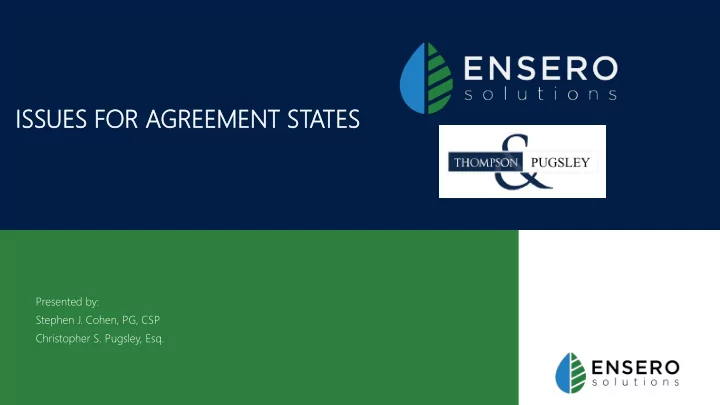

ISSU SUES ES FOR OR AGR GREEME MENT NT STATE TES Presented by: Stephen J. Cohen, PG, CSP Christopher S. Pugsley, Esq.
Ag Agen enda da ▪ Overview of the Integrated Materials Performance Assessment Program (IMPEP) ▪ Review of Issues Identified by the U.S. Nuclear Regulatory Commission (USNRC) ▪ Potential Solutions 2
Ov Over ervie iew w of IMP MPEP P Pr Progr gram am ▪ Integrated Materials Performance Assessment Program ▪ U.S. Nuclear Regulatory Commission’s Agreement State inspection program ▪ Areas of inspection (MD 5.6) ▪ Common Performance Indicators ▪ T echnical staffing and training ▪ Status of materials inspection program ▪ T echnical quality of inspections ▪ T echnical quality of licensing actions ▪ T echnical Quality of incident and allegation activities ▪ Non-Common Performance Indicators ▪ Regulatory/statutory compatibility requirements ▪ Sealed sources and devices ▪ Low-level radioactive waste ▪ Uranium recovery 3
Overview of IMPEP Program (cont’d.) ▪ Guidance documents are basis of review ▪ SA Series: SA-100 (General Implementation) ▪ SA-101 through -105 (Common), -107 through -110 (Non-Common) ▪ Inspection Manual Chapter Series ▪ Management Directives 5.6 and 5.9 ▪ Inspection Frequency (SA-100) ▪ Normally, USNRC Regional and Agreement State program reviews are scheduled every four years; ▪ Interval may be shortened or lengthened to another appropriate interval based on the review team’s recommendation ▪ Separate trips to perform specific parts of an IMPEP review are permitted and may be advantageous to the Agreement State and/or USNRC. Examples are accompaniments of inspectors and visits to specific licensed facilities. Such activities; however, should be completed prior to the review exit meeting. ▪ USNRC might be moving to remote IMPEP inspections due to COVID-19 4
Overview of IMPEP Program (cont’d.) ▪ Follow-up reviews – limited evaluation specific to findings ▪ Special reviews – address specific challenges facing a program ▪ Implementation ▪ Review questionnaire ▪ Offsite review ▪ Onsite review ▪ Inspection observations ▪ Personnel interviews ▪ IMPEP staff ▪ USNRC personnel ▪ Agreement State personnel – SA-120 5
Rev evie iew w of Iss ssue ues s Ide dent ntifie ified d by by the he USNR NRC ▪ Adequacy and compatibility with USNRC Regulations ▪ Training and qualification programs were not compatible with appropriate Inspection Manual Chapters ▪ Inspection results not communicated to licensees in a timely fashion or poorly documented ▪ Failure to implement inspection procedures ▪ Insufficient training of inspectors ▪ Inadequate licensing procedures ▪ Inadequate incident and allegation investigation execution ▪ Inadequate staffing or staff retention ▪ License application or amendment application reviews that did not meet requirements of guidance ▪ Documentation of training and experience for users of radioactive materials. 6
Poten ential tial Solu lutio tions ns ▪ Adequacy and Compatibility with USNRC Regulations ▪ Before proposing new regulations, meet with USNRC, Agreement State Program staff to discuss the regulations to ensure that no conflicts exist. ▪ Engage industry experts to review regulations prior to promulgation to identify potential problems. ▪ Training and qualification programs were not compatible with appropriate Inspection Manual Chapters ▪ Ensure that checklists are developed and that management reviews and signs checklists ▪ Ensure that training programs include all necessary topics found in IMCs; use IMCs, Management Directives as training guides ▪ Ensure training includes both classroom learning and field demonstrations ▪ Confirmation of training should be required: ▪ T ests ▪ Field Practicals 7
Potential Solutions (cont’d.) ▪ Inspection results not communicated to licensees in a timely fashion or poorly documented ▪ Ensure that standardized inspection forms are utilized ▪ Ensure that managers are observing inspections to determine if inspections are being properly performed and documented ▪ Ensure that training addresses proper documentation and communication of inspection findings ▪ Develop a tracking database or spreadsheet with appropriate deadlines to ensure that inspection results are communicated promptly. ▪ Failure to implement inspection procedures ▪ Review inspection procedures to ensure completeness and compatibility with NRC Regulations ▪ Review inspection training procedures to ensure proper training ▪ Retrain inspectors through classroom education and field practicals ▪ Training and procedures reviews could include third-party services 8
Potential Solutions (cont’d.) ▪ Insufficient training of inspectors ▪ Review inspection training procedures to ensure proper training ▪ Retrain inspectors through classroom education and field practicals ▪ Training and procedures reviews could include third-party services ▪ Inadequate licensing procedures ▪ Review license review procedures ▪ Develop new procedures that are consistent with guidance documents (NUREG-1556, -1569) ▪ Retrain licensing staff ▪ Classroom training ▪ Management reviews of licensing documents 9
Potential Solutions (cont’d.) ▪ Inadequate incident and allegation investigation execution ▪ Review incident and allegation procedures ▪ Ensure that proper forms for documenting initial contacts are properly developed ▪ Ensure that all personnel understand confidentiality regulations ▪ Determine the need to train specific personnel for addressing incidents and allegations ▪ Retrain all responsible personnel on procedures ▪ Classroom training ▪ Drills ▪ Inadequate staffing or staff retention ▪ Inadequate staffing could be budget related. ▪ Poor staff retention could be related to: ▪ Salary ▪ Unsatisfactory job responsibilities ▪ Unsatisfactory relationship with management 10
Potential Solutions (cont’d.) ▪ Poor work environment ▪ Harassment/HR issues ▪ Although causes for poor staff retention are outside the scope of the AEA, the ramifications are within the scope ▪ Reduced effectiveness in implementing the Agreement State program ▪ Reduced effectiveness in protecting public health and the environment ▪ Reduced effectiveness in controlling regulated materials ▪ Human resources support, either internal or external, would be needed to resolve some retention issues. 11
Potential Solutions (cont’d.) ▪ License application or amendment application reviews that did not meet requirements of guidance ▪ Retrain licensing staff ▪ Classroom training ▪ Sample license application review ▪ Management inspection of licensing review 12
Stephen J. Cohen, PG, CSP Christopher S. Pugsley, Esq. Ensero Solutions US, Inc. Thompson & Pugsley, PLLC 12150 East Briarwood Avenue 1225 19th Street NW Suite 135 Suite 300 Centennial, CO 80112 Washington, DC 20036 719-204-7036 (P) 202-496-0780 (P) 720-237-2358 (M) 202-870-3387 (M) scohen@ensero.com cpugsley@athompsonlaw.com 13
Recommend
More recommend